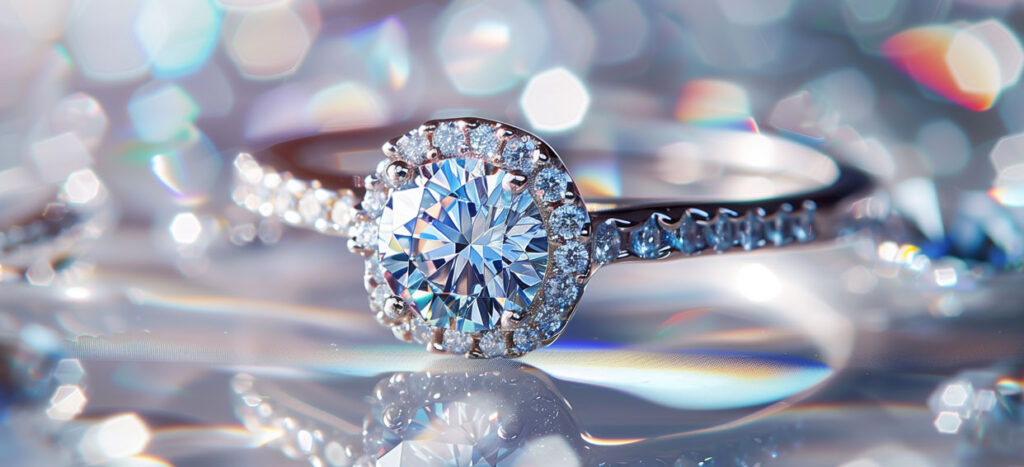Engagement rings have long served as a powerful symbol of love, commitment, and the promise of a lifelong partnership. From ancient customs to modern designs, these rings are more than just beautiful pieces of jewelry—they carry a deep cultural and emotional significance that has evolved through centuries. This article will take you on a journey through time, exploring how engagement rings have reflected love, social status, and tradition across different eras.
At Carat Diamonds, we believe that each engagement ring tells its own love story, making every piece a timeless treasure.
Ancient Origins: Circles of Eternity
The tradition of engagement rings dates back thousands of years to ancient Egypt. Egyptians believed the circular shape of the ring symbolized eternity, with no beginning and no end, much like their view of love and commitment. These early rings were often made from braided reeds or hemp and worn on the fourth finger of the left hand—a tradition still observed today in many cultures. This finger was believed to have a vein that ran directly to the heart, the “vena amoris,” or vein of love.
Roman Empire: The Metal Bands of Commitment
In ancient Rome, engagement rings became more formalized, with iron being the material of choice. Roman women wore simple iron bands to symbolize the strength and durability of their commitment. However, over time, wealthier Romans began to favor gold rings, which not only represented love but also wealth and social status. These rings were sometimes inscribed with personal messages or symbols, reflecting the couple’s bond.
Medieval Times: Gemstones and Royalty
By the Middle Ages, gemstones became a prominent feature in engagement rings, marking a shift in both design and significance. Gemstones such as sapphires, rubies, and emeralds were popular, each chosen for its symbolic meaning—sapphires for loyalty, rubies for passion, and emeralds for fertility. In 1477, Archduke Maximilian of Austria gave Mary of Burgundy the first recorded diamond engagement ring, sparking a trend among European nobility. Diamonds, believed to be the hardest substance on Earth, symbolized unbreakable love and eternal commitment.
Renaissance and Victorian Eras: Romance and Intricacy
The Renaissance era brought more ornate and intricate designs, with engagement rings becoming a romantic symbol of love. Gold and silver bands set with diamonds and colored gemstones were popular among the aristocracy. This period also saw the introduction of engraved rings with personal messages and symbols of love.
The Victorian era, spanning from 1837 to 1901, continued this trend, with engagement rings incorporating nature-inspired designs, including flowers, hearts, and leaves. Diamonds were still highly prized, but other gemstones, such as garnets and opals, were also used. Many Victorian rings were crafted in yellow or rose gold, styles that remain popular today. At Carat Diamonds, we offer a selection of vintage-inspired engagement rings that capture the beauty of this era.
Edwardian Era: Elegance and Platinum
At the turn of the 20th century, the Edwardian era brought a new level of elegance to engagement rings. Platinum became the metal of choice for its strength and ability to hold delicate, lace-like designs. Rings from this period often featured diamonds in intricate settings, with milgrain and filigree details that added a touch of sophistication. This era’s emphasis on craftsmanship and elegance is reflected in the classic designs offered at Carat Diamonds.
Art Deco: Bold and Geometric
The Art Deco period of the 1920s and 1930s introduced bold, geometric patterns to engagement ring design. Influenced by the modernist movement, Art Deco rings featured strong, clean lines, symmetrical designs, and a mix of diamonds with colorful gemstones like sapphires, emeralds, and rubies. Platinum remained the metal of choice, and rings from this period are often characterized by their vibrant colors and unique shapes. For those seeking a vintage look with modern flair, Carat Diamonds offers stunning Art Deco-inspired engagement rings.
The 20th Century: The Diamond Reign
In the mid-20th century, diamonds solidified their place as the gemstone of choice for engagement rings, thanks largely to a marketing campaign by De Beers. The slogan “A Diamond is Forever” resonated with couples around the world, linking diamonds to eternal love and commitment. The classic diamond solitaire, set in gold or platinum, became the most iconic engagement ring style, a trend that continues today.
Modern Engagement Rings: Personalization and Inclusivity
In today’s world, engagement rings are more diverse and personalized than ever before. While diamonds remain a popular choice, many couples are opting for alternative gemstones, unique designs, and ethical options such as lab-grown diamonds. Personalization is key, with many choosing custom-made rings that reflect their individual love story.
At Carat Diamonds, we offer a wide range of engagement rings that cater to every taste and style. Whether you’re looking for a traditional diamond ring, a vintage-inspired design, or something completely unique, we have the perfect ring to symbolize your love.
Conclusion: A Timeless Symbol of Love
Engagement rings have endured through centuries as symbols of love, commitment, and cultural significance. From the simple iron bands of ancient Rome to the diamond-studded masterpieces of today, engagement rings reflect the changing values and styles of different eras. Yet, despite their evolution in design and material, their core meaning remains the same—a reflection of eternal love and the promise of a future together.
At Carat Diamonds, we celebrate the timeless allure of engagement rings by offering pieces that honor both tradition and modern innovation. Explore our collection and find the perfect ring that will tell your love story for generations to come.



